Generic tools#
Below we briefly introduce some of the most commonly used tools (methods). For
more details about a particular method click on its name. For a detailed list
of all the methods available see the BaseSignal documentation.
The methods of this section are available to all the signals. In other chapters methods that are only available in specialized subclasses are listed.
Mathematical operations#
A number of mathematical operations are available
in BaseSignal. Most of them are just wrapped numpy
functions.
The methods that perform mathematical operation over one or more axis at a time are:
Note that by default all this methods perform the operation over all navigation axes.
Example:
>>> s = hs.signals.BaseSignal(np.random.random((2,4,6)))
>>> s.axes_manager[0].name = 'E'
>>> s
<BaseSignal, title: , dimensions: (|6, 4, 2)>
>>> # by default perform operation over all navigation axes
>>> s.sum()
<BaseSignal, title: , dimensions: (|6, 4, 2)>
>>> # can also pass axes individually
>>> s.sum('E')
<Signal2D, title: , dimensions: (|4, 2)>
>>> # or a tuple of axes to operate on, with duplicates, by index or directly
>>> ans = s.sum((-1, s.axes_manager[1], 'E', 0))
>>> ans
<BaseSignal, title: , dimensions: (|1)>
>>> ans.axes_manager[0]
<Scalar axis, size: 1>
The following methods operate only on one axis at a time:
All numpy ufunc can operate on BaseSignal
instances, for example:
>>> s = hs.signals.Signal1D([0, 1])
>>> s.metadata.General.title = "A"
>>> s
<Signal1D, title: A, dimensions: (|2)>
>>> np.exp(s)
<Signal1D, title: exp(A), dimensions: (|2)>
>>> np.exp(s).data
array([1. , 2.71828183])
>>> np.power(s, 2)
<Signal1D, title: power(A, 2), dimensions: (|2)>
>>> np.add(s, s)
<Signal1D, title: add(A, A), dimensions: (|2)>
>>> np.add(hs.signals.Signal1D([0, 1]), hs.signals.Signal1D([0, 1]))
<Signal1D, title: add(Untitled Signal 1, Untitled Signal 2), dimensions: (|2)>
Notice that the title is automatically updated. When the signal has no title a new title is automatically generated:
>>> np.add(hs.signals.Signal1D([0, 1]), hs.signals.Signal1D([0, 1]))
<Signal1D, title: add(Untitled Signal 1, Untitled Signal 2), dimensions: (|2)>
Functions (other than unfucs) that operate on numpy arrays can also operate
on BaseSignal instances, however they return a numpy
array instead of a BaseSignal instance e.g.:
>>> np.angle(s)
array([0., 0.])
Note
For numerical differentiation and integration, use the proper
methods derivative() and
integrate1D(). In certain cases, particularly
when operating on a non-uniform axis, the approximations using the
diff() and sum()
methods will lead to erroneous results.
Signal operations#
BaseSignal supports all the Python binary arithmetic
operations (+, -, *, //, %, divmod(), pow(), **, <<, >>, &, ^, |),
augmented binary assignments (+=, -=, *=, /=, //=, %=, **=, <<=, >>=, &=,
^=, |=), unary operations (-, +, abs() and ~) and rich comparisons operations
(<, <=, ==, x!=y, <>, >, >=).
These operations are performed element-wise. When the dimensions of the signals are not equal numpy broadcasting rules apply independently for the navigation and signal axes.
Warning
Hyperspy does not check if the calibration of the signals matches.
In the following example s2 has only one navigation axis while s has two. However, because the size of their first navigation axis is the same, their dimensions are compatible and s2 is broadcasted to match s’s dimensions.
>>> s = hs.signals.Signal2D(np.ones((3,2,5,4)))
>>> s2 = hs.signals.Signal2D(np.ones((2,5,4)))
>>> s
<Signal2D, title: , dimensions: (2, 3|4, 5)>
>>> s2
<Signal2D, title: , dimensions: (2|4, 5)>
>>> s + s2
<Signal2D, title: , dimensions: (2, 3|4, 5)>
In the following example the dimensions are not compatible and an exception is raised.
>>> s = hs.signals.Signal2D(np.ones((3,2,5,4)))
>>> s2 = hs.signals.Signal2D(np.ones((3,5,4)))
>>> s
<Signal2D, title: , dimensions: (2, 3|4, 5)>
>>> s2
<Signal2D, title: , dimensions: (3|4, 5)>
>>> s + s2
Traceback (most recent call last):
File "<ipython-input-55-044bb11a0bd9>", line 1, in <module>
s + s2
File "<string>", line 2, in __add__
File "/home/fjd29/Python/hyperspy/hyperspy/signal.py", line 2686, in _binary_operator_ruler
raise ValueError(exception_message)
ValueError: Invalid dimensions for this operation
Broadcasting operates exactly in the same way for the signal axes:
>>> s = hs.signals.Signal2D(np.ones((3,2,5,4)))
>>> s2 = hs.signals.Signal1D(np.ones((3, 2, 4)))
>>> s
<Signal2D, title: , dimensions: (2, 3|4, 5)>
>>> s2
<Signal1D, title: , dimensions: (2, 3|4)>
>>> s + s2
<Signal2D, title: , dimensions: (2, 3|4, 5)>
In-place operators also support broadcasting, but only when broadcasting would not change the left most signal dimensions:
>>> s += s2
>>> s
<Signal2D, title: , dimensions: (2, 3|4, 5)>
>>> s2 += s
Traceback (most recent call last):
File "<ipython-input-64-fdb9d3a69771>", line 1, in <module>
s2 += s
File "<string>", line 2, in __iadd__
File "/home/fjd29/Python/hyperspy/hyperspy/signal.py", line 2737, in _binary_operator_ruler
self.data = getattr(sdata, op_name)(odata)
ValueError: non-broadcastable output operand with shape (3,2,1,4) doesn\'t match the broadcast shape (3,2,5,4)
Iterating external functions with the map method#
Performing an operation on the data at each coordinate, as in the previous example,
using an external function can be more easily accomplished using the
map() method:
>>> import scipy.ndimage
>>> image_stack = hs.signals.Signal2D(np.array([scipy.datasets.ascent()]*4))
>>> image_stack.axes_manager[1].name = "x"
>>> image_stack.axes_manager[2].name = "y"
>>> image_stack.map(scipy.ndimage.rotate, angle=45, reshape=False)
>>> # clip data to integer range
>>> image_stack.data = np.clip(image_stack.data, 0, 255)
>>> collage = hs.stack([image for image in image_stack], axis=0)
>>> collage.plot()

The map() method can also take variable
arguments as in the following example.
>>> import scipy.ndimage
>>> image_stack = hs.signals.Signal2D(np.array([scipy.datasets.ascent()]*4))
>>> image_stack.axes_manager[1].name = "x"
>>> image_stack.axes_manager[2].name = "y"
>>> angles = hs.signals.BaseSignal(np.array([0, 45, 90, 135]))
>>> image_stack.map(scipy.ndimage.rotate, angle=angles.T, reshape=False)

Rotation of images using map() with different
arguments for each image in the stack.#
Added in version 1.2.0: inplace keyword and non-preserved output shapes
If all function calls do not return identically-shaped results, only navigation information is preserved, and the final result is an array where each element corresponds to the result of the function (or arbitrary object type). These are ragged arrays and has the dtype object. As such, most HyperSpy functions cannot operate on such signals, and the data should be accessed directly.
The inplace keyword (by default True) of the
map() method allows either overwriting the current
data (default, True) or storing it to a new signal (False).
>>> import scipy.ndimage
>>> image_stack = hs.signals.Signal2D(np.array([scipy.datasets.ascent()]*4))
>>> angles = hs.signals.BaseSignal(np.array([0, 45, 90, 135]))
>>> result = image_stack.map(scipy.ndimage.rotate,
... angle=angles.T,
... inplace=False,
... ragged=True,
... reshape=True)
>>> result
<BaseSignal, title: , dimensions: (4|ragged)>
>>> result.data.dtype
dtype('O')
>>> for d in result.data.flat:
... print(d.shape)
(512, 512)
(724, 724)
(512, 512)
(724, 724)
Added in version 1.4: Iterating over signal using a parameter with no navigation dimension.
In this case, the parameter is cyclically iterated over the navigation dimension of the input signal. In the example below, signal s is multiplied by a cosine parameter d, which is repeated over the navigation dimension of s.
>>> s = hs.signals.Signal1D(np.random.rand(10, 512))
>>> d = hs.signals.Signal1D(np.cos(np.linspace(0., 2*np.pi, 512)))
>>> s.map(lambda A, B: A * B, B=d)
Added in version 1.7: Get result as lazy signal
Especially when working with very large datasets, it can be useful to not do the computation immediately. For example if it would make you run out of memory. In that case, the lazy_output parameter can be used.
>>> from scipy.ndimage import gaussian_filter
>>> s = hs.signals.Signal2D(np.random.random((4, 4, 128, 128)))
>>> s_out = s.map(gaussian_filter, sigma=5, inplace=False, lazy_output=True)
>>> s_out
<LazySignal2D, title: , dimensions: (4, 4|128, 128)>
s_out can then be saved to a hard drive, to avoid it being loaded into memory. Alternatively, it can be computed and loaded into memory using s_out.compute()
>>> s_out.save("gaussian_filter_file.hspy")
Another advantage of using lazy_output=True is the ability to “chain” operations,
by running map() on the output from a previous
map() operation.
For example, first running a Gaussian filter, followed by peak finding. This can
improve the computation time, and reduce the memory need.
>>> s_out = s.map(scipy.ndimage.gaussian_filter, sigma=5, inplace=False, lazy_output=True)
>>> from skimage.feature import blob_dog
>>> s_out1 = s_out.map(blob_dog, threshold=0.05, inplace=False, ragged=True, lazy_output=False)
>>> s_out1
<BaseSignal, title: , dimensions: (4, 4|ragged)>
This is especially relevant for very large datasets, where memory use can be a limiting factor.
Cropping#
Cropping can be performed in a very compact and powerful way using
Indexing . In addition it can be performed using the following
method or GUIs if cropping signal1D or signal2D. There is also a general crop()
method that operates in place.
Rebinning#
Added in version 1.3: rebin() generalized to remove the constrain
of the new_shape needing to be a divisor of data.shape.
The rebin() methods supports rebinning the data to
arbitrary new shapes as long as the number of dimensions stays the same.
However, internally, it uses two different algorithms to perform the task. Only
when the new shape dimensions are divisors of the old shape’s, the operation
supports lazy-evaluation and is usually faster.
Otherwise, the operation requires linear interpolation.
For example, the following two equivalent rebinning operations can be performed lazily:
>>> s = hs.data.two_gaussians().as_lazy()
>>> print(s)
<LazySignal1D, title: Two Gaussians, dimensions: (32, 32|1024)>
>>> print(s.rebin(scale=[1, 1, 2]))
<LazySignal1D, title: Two Gaussians, dimensions: (32, 32|512)>
>>> s = hs.data.two_gaussians().as_lazy()
>>> print(s.rebin(new_shape=[32, 32, 512]))
<LazySignal1D, title: Two Gaussians, dimensions: (32, 32|512)>
On the other hand, the following rebinning operation requires interpolation and cannot be performed lazily:
>>> s = hs.signals.Signal1D(np.ones([4, 4, 10]))
>>> s.data[1, 2, 9] = 5
>>> print(s)
<Signal1D, title: , dimensions: (4, 4|10)>
>>> print ('Sum = ', s.data.sum())
Sum = 164.0
>>> scale = [0.5, 0.5, 5]
>>> test = s.rebin(scale=scale)
>>> test2 = s.rebin(new_shape=(8, 8, 2)) # Equivalent to the above
>>> print(test)
<Signal1D, title: , dimensions: (8, 8|2)>
>>> print(test2)
<Signal1D, title: , dimensions: (8, 8|2)>
>>> print('Sum =', test.data.sum())
Sum = 164.0
>>> print('Sum =', test2.data.sum())
Sum = 164.0
>>> s.as_lazy().rebin(scale=scale)
Traceback (most recent call last):
File "<ipython-input-26-49bca19ebf34>", line 1, in <module>
spectrum.as_lazy().rebin(scale=scale)
File "/home/fjd29/Python/hyperspy3/hyperspy/_signals/eds.py", line 184, in rebin
m = super().rebin(new_shape=new_shape, scale=scale, crop=crop, out=out)
File "/home/fjd29/Python/hyperspy3/hyperspy/_signals/lazy.py", line 246, in rebin
"Lazy rebin requires scale to be integer and divisor of the "
NotImplementedError: Lazy rebin requires scale to be integer and divisor of the original signal shape
The dtype argument can be used to specify the dtype of the returned
signal:
>>> s = hs.signals.Signal1D(np.ones((2, 5, 10), dtype=np.uint8))
>>> print(s)
<Signal1D, title: , dimensions: (5, 2|10)>
>>> print(s.data.dtype)
uint8
Use dtype=np.unit16 to specify a dtype:
>>> s2 = s.rebin(scale=(5, 2, 1), dtype=np.uint16)
>>> print(s2.data.dtype)
uint16
Use dtype="same" to keep the same dtype:
>>> s3 = s.rebin(scale=(5, 2, 1), dtype="same")
>>> print(s3.data.dtype)
uint8
By default dtype=None, the dtype is determined by the behaviour of
numpy.sum, in this case, unsigned integer of the same precision as the
platform interger:
>>> s4 = s.rebin(scale=(5, 2, 1))
>>> print(s4.data.dtype)
uint32
Interpolate to a different axis#
The interpolate_on_axis() method makes it possible to
exchange any existing axis of a signal with a new axis,
regardless of the signals dimension or the axes types.
This is achieved by interpolating the data using scipy.interpolate.make_interp_spline()
from the old axis to the new axis. Replacing multiple axes can be done iteratively.
>>> from hyperspy.axes import UniformDataAxis, DataAxis
>>> x = {"offset": 0, "scale": 1, "size": 10, "name": "X", "navigate": True}
>>> e = {"offset": 0, "scale": 1, "size": 50, "name": "E", "navigate": False}
>>> s = hs.signals.Signal1D(np.random.random((10, 50)), axes=[x, e])
>>> s
<Signal1D, title: , dimensions: (10|50)>
>>> x_new = UniformDataAxis(offset=1.5, scale=0.8, size=7, name="X_NEW", navigate=True)
>>> e_new = DataAxis(axis=np.arange(8)**2, name="E_NEW", navigate=False)
>>> s2 = s.interpolate_on_axis(x_new, 0, inplace=False)
>>> s2
<Signal1D, title: , dimensions: (7|50)>
>>> s2.interpolate_on_axis(e_new, "E", inplace=True)
>>> s2
<Signal1D, title: , dimensions: (7|8)>
Squeezing#
The squeeze() method removes any zero-dimensional
axes, i.e. axes of size=1, and the attributed data dimensions from a signal.
The method returns a reduced copy of the signal and does not operate in place.
>>> s = hs.signals.Signal2D(np.random.random((2, 1, 1, 6, 8, 8)))
>>> s
<Signal2D, title: , dimensions: (6, 1, 1, 2|8, 8)>
>>> s = s.squeeze()
>>> s
<Signal2D, title: , dimensions: (6, 2|8, 8)>
Squeezing can be particularly useful after a rebinning operation that leaves
one dimension with shape=1:
>>> s = hs.signals.Signal2D(np.random.random((5,5,5,10,10)))
>>> s.rebin(new_shape=(5,1,5,5,5))
<Signal2D, title: , dimensions: (5, 1, 5|5, 5)>
>>> s.rebin(new_shape=(5,1,5,5,5)).squeeze()
<Signal2D, title: , dimensions: (5, 5|5, 5)>
Folding and unfolding#
When dealing with multidimensional datasets it is sometimes useful to transform the data into a two dimensional dataset. This can be accomplished using the following two methods:
It is also possible to unfold only the navigation or only the signal space:
Splitting and stacking#
Several objects can be stacked together over an existing axis or over a
new axis using the stack() function, if they share axis
with same dimension.
>>> image = hs.signals.Signal2D(scipy.datasets.ascent())
>>> image = hs.stack([hs.stack([image]*3,axis=0)]*3,axis=1)
>>> image.plot()
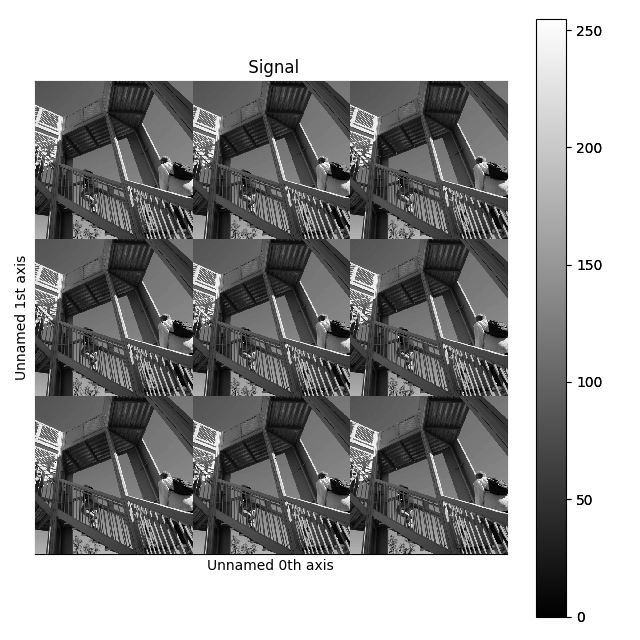
Stacking example.#
Note
When stacking signals with large amount of
original_metadata, these metadata will be
stacked and this can lead to very large amount of metadata which can in
turn slow down processing. The stack_original_metadata argument can be
used to disable stacking original_metadata.
An object can be split into several objects
with the split() method. This function can be used
to reverse the stack() function:
>>> image = image.split()[0].split()[0]
>>> image.plot()
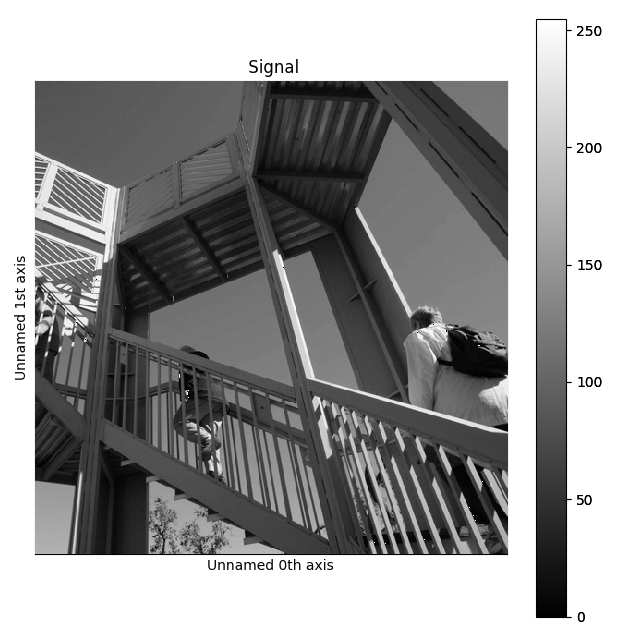
Splitting example.#
Fast Fourier Transform (FFT)#
The fast Fourier transform
of a signal can be computed using the fft() method. By default,
the FFT is calculated with the origin at (0, 0), which will be displayed at the
bottom left and not in the centre of the FFT. Conveniently, the shift argument of the
the fft() method can be used to center the output of the FFT.
In the following example, the FFT of a hologram is computed using shift=True and its
output signal is displayed, which shows that the FFT results in a complex signal with a
real and an imaginary parts:
>>> im = hs.data.wave_image()
>>> fft_shifted = im.fft(shift=True)
>>> fft_shifted.plot()
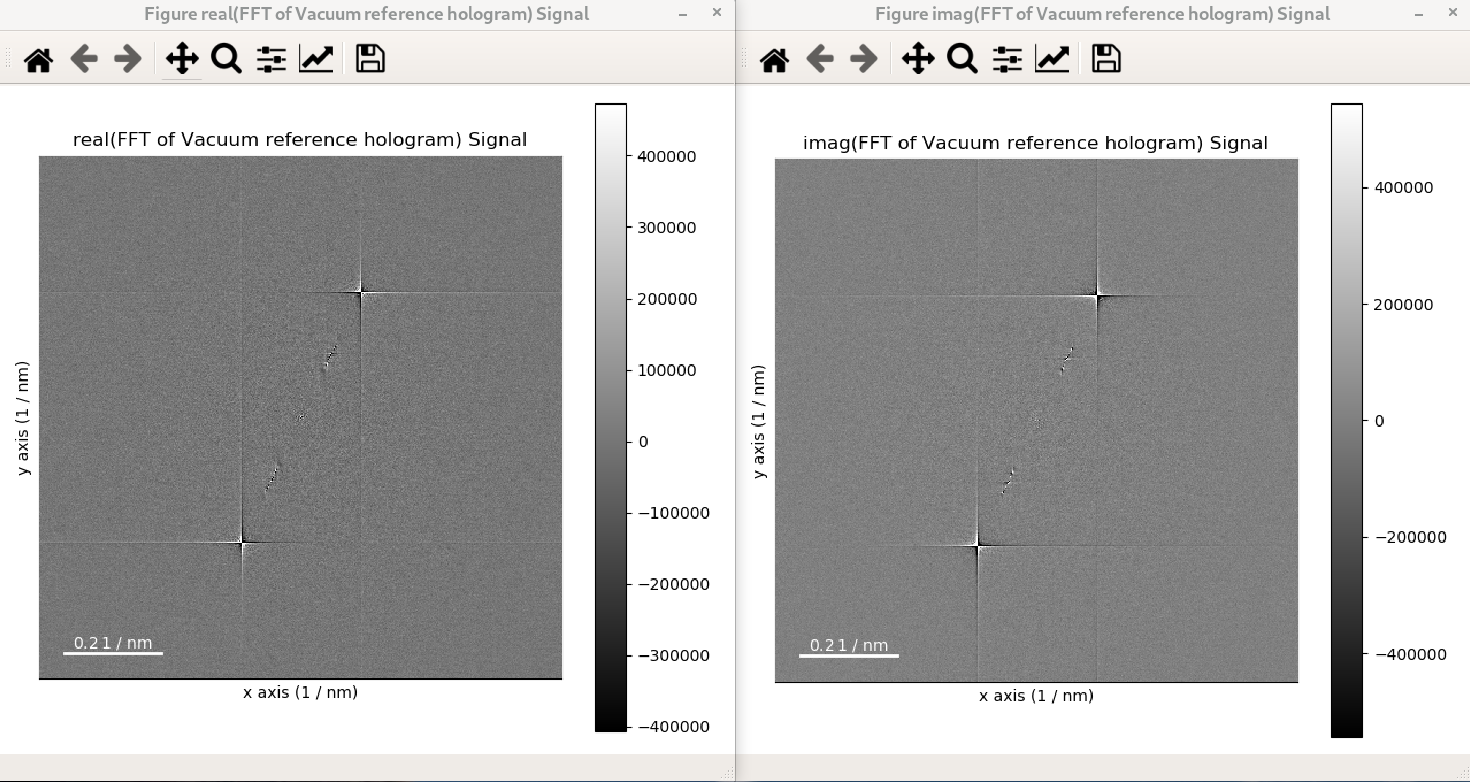
The strong features in the real and imaginary parts correspond to the lattice fringes of the hologram.
For visual inspection of the FFT it is convenient to display its power spectrum
(i.e. the square of the absolute value of the FFT) rather than FFT itself as it is done
in the example above by using the power_spectum argument:
>>> im = hs.data.wave_image()
>>> fft = im.fft(True)
>>> fft.plot(True)
Where power_spectum is set to True since it is the first argument of the
plot() method for complex signal.
When power_spectrum=True, the plot will be displayed on a log scale by default.
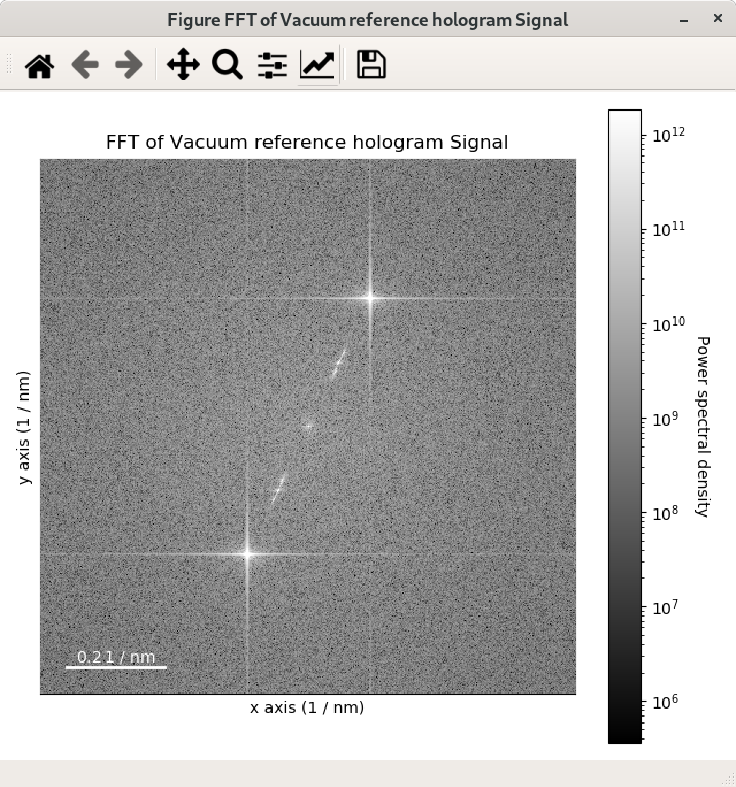
The visualisation can be further improved by setting the minimum value to display to the 30-th
percentile; this can be done by using vmin="30th" in the plot function:
>>> im = hs.data.wave_image()
>>> fft = im.fft(True)
>>> fft.plot(True, vmin="30th")

The streaks visible in the FFT come from the edge of the image and can be removed by
applying an apodization function to the original
signal before the computation of the FFT. This can be done using the apodization argument of
the fft() method and it is usually used for visualising FFT patterns
rather than for quantitative analyses. By default, the so-called hann windows is
used but different type of windows such as the hamming and tukey windows.
>>> im = hs.data.wave_image()
>>> fft = im.fft(shift=True)
>>> fft_apodized = im.fft(shift=True, apodization=True)
>>> fft_apodized.plot(True, vmin="30th")
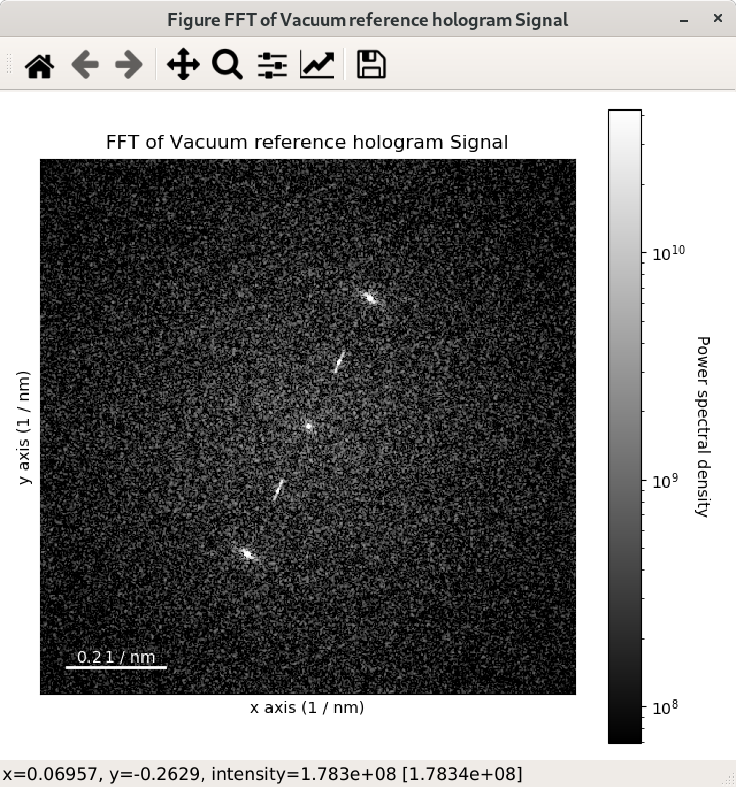
Inverse Fast Fourier Transform (iFFT)#
Inverse fast Fourier transform can be calculated from a complex signal by using the
ifft() method. Similarly to the fft() method,
the shift argument can be provided to shift the origin of the iFFT when necessary:
>>> im_ifft = im.fft(shift=True).ifft(shift=True)
Changing the data type#
Even if the original data is recorded with a limited dynamic range, it is often
desirable to perform the analysis operations with a higher precision.
Conversely, if space is limited, storing in a shorter data type can decrease
the file size. The change_dtype() changes the data
type in place, e.g.:
>>> s = hs.load('EELS Signal1D Signal2D (high-loss).dm3')
Title: EELS Signal1D Signal2D (high-loss).dm3
Signal type: EELS
Data dimensions: (21, 42, 2048)
Data representation: spectrum
Data type: float32
>>> s.change_dtype('float64')
>>> print(s)
Title: EELS Signal1D Signal2D (high-loss).dm3
Signal type: EELS
Data dimensions: (21, 42, 2048)
Data representation: spectrum
Data type: float64
In addition to all standard numpy dtypes, HyperSpy supports four extra dtypes
for RGB images for visualization purposes only: rgb8, rgba8,
rgb16 and rgba16. This includes of course multi-dimensional RGB images.
The requirements for changing from and to any rgbx dtype are more strict
than for most other dtype conversions. To change to a rgbx dtype the
signal_dimension must be 1 and its size 3 (4) 3(4) for rgb (or
rgba) dtypes and the dtype must be uint8 (uint16) for
rgbx8 (rgbx16). After conversion the signal_dimension becomes 2.
Most operations on signals with RGB dtypes will fail. For processing simply
change their dtype to uint8 (uint16).The dtype of images of
dtype rgbx8 (rgbx16) can only be changed to uint8 (uint16) and
the signal_dimension becomes 1.
In the following example we create a 1D signal with signal size 3 and with
dtype uint16 and change its dtype to rgb16 for plotting.
>>> rgb_test = np.zeros((1024, 1024, 3))
>>> ly, lx = rgb_test.shape[:2]
>>> offset_factor = 0.16
>>> size_factor = 3
>>> Y, X = np.ogrid[0:lx, 0:ly]
>>> rgb_test[:,:,0] = (X - lx / 2 - lx*offset_factor) ** 2 + \
... (Y - ly / 2 - ly*offset_factor) ** 2 < \
... lx * ly / size_factor **2
>>> rgb_test[:,:,1] = (X - lx / 2 + lx*offset_factor) ** 2 + \
... (Y - ly / 2 - ly*offset_factor) ** 2 < \
... lx * ly / size_factor **2
>>> rgb_test[:,:,2] = (X - lx / 2) ** 2 + \
... (Y - ly / 2 + ly*offset_factor) ** 2 \
... < lx * ly / size_factor **2
>>> rgb_test *= 2**16 - 1
>>> s = hs.signals.Signal1D(rgb_test)
>>> s.change_dtype("uint16")
>>> s
<Signal1D, title: , dimensions: (1024, 1024|3)>
>>> s.change_dtype("rgb16")
>>> s
<Signal2D, title: , dimensions: (|1024, 1024)>
>>> s.plot()
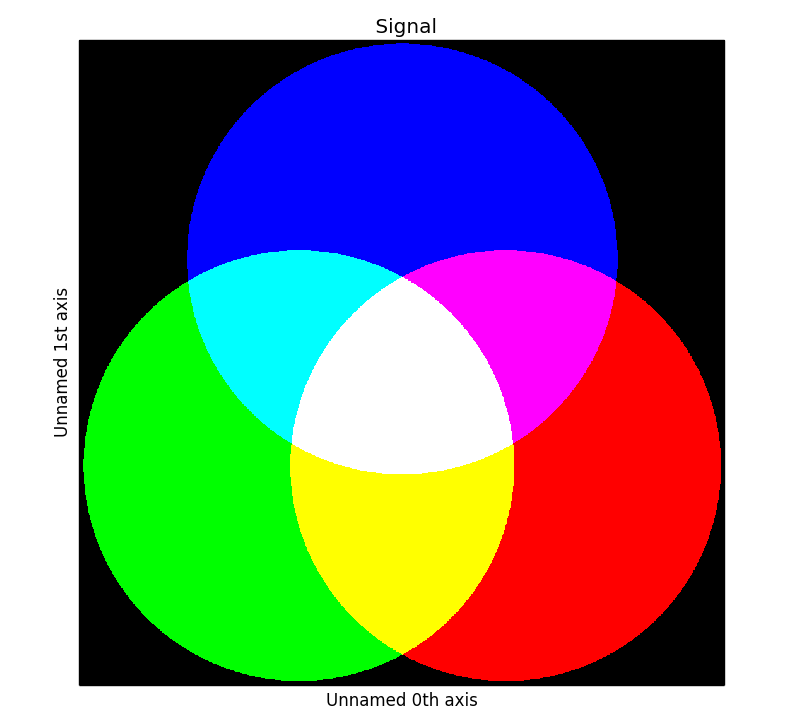
RGB data type example.#
Transposing (changing signal spaces)#
Added in version 1.1.
transpose() method changes how the dataset
dimensions are interpreted (as signal or navigation axes). By default is
swaps the signal and navigation axes. For example:
>>> s = hs.signals.Signal1D(np.zeros((4,5,6)))
>>> s
<Signal1D, title: , dimensions: (5, 4|6)>
>>> s.transpose()
<Signal2D, title: , dimensions: (6|5, 4)>
For T() is a shortcut for the default behaviour:
>>> s = hs.signals.Signal1D(np.zeros((4,5,6))).T
>>> s
<Signal2D, title: , dimensions: (6|5, 4)>
The method accepts both explicit axes to keep in either space, or just a number
of axes required in one space (just one number can be specified, as the other
is defined as “all other axes”). When axes order is not explicitly defined,
they are “rolled” from one space to the other as if the <navigation axes |
signal axes > wrap a circle. The example below should help clarifying this.
>>> # just create a signal with many distinct dimensions
>>> s = hs.signals.BaseSignal(np.random.rand(1, 2, 3, 4, 5, 6, 7, 8, 9))
>>> s
<BaseSignal, title: , dimensions: (|9, 8, 7, 6, 5, 4, 3, 2, 1)>
>>> s.transpose(signal_axes=5) # roll to leave 5 axes in signal space
<BaseSignal, title: , dimensions: (4, 3, 2, 1|9, 8, 7, 6, 5)>
>>> s.transpose(navigation_axes=3) # roll leave 3 axes in navigation space
<BaseSignal, title: , dimensions: (3, 2, 1|9, 8, 7, 6, 5, 4)>
>>> # 3 explicitly defined axes in signal space
>>> s.transpose(signal_axes=[0, 2, 6])
<BaseSignal, title: , dimensions: (8, 6, 5, 4, 2, 1|9, 7, 3)>
>>> # A mix of two lists, but specifying all axes explicitly
>>> # The order of axes is preserved in both lists
>>> s.transpose(navigation_axes=[1, 2, 3, 4, 5, 8], signal_axes=[0, 6, 7])
<BaseSignal, title: , dimensions: (8, 7, 6, 5, 4, 1|9, 3, 2)>
A convenience functions transpose() is available to operate on
many signals at once, for example enabling plotting any-dimension signals
trivially:
>>> s2 = hs.signals.BaseSignal(np.random.rand(2, 2)) # 2D signal
>>> s3 = hs.signals.BaseSignal(np.random.rand(3, 3, 3)) # 3D signal
>>> s4 = hs.signals.BaseSignal(np.random.rand(4, 4, 4, 4)) # 4D signal
>>> hs.plot.plot_images(hs.transpose(s2, s3, s4, signal_axes=2))
The transpose() method accepts keyword argument
optimize, which is False by default, meaning modifying the output
signal data always modifies the original data i.e. the data is just a view
of the original data. If True, the method ensures the data in memory is
stored in the most efficient manner for iterating by making a copy of the data
if required, hence modifying the output signal data not always modifies the
original data.
The convenience methods as_signal1D() and
as_signal2D() internally use
transpose(), but always optimize the data
for iteration over the navigation axes if required. Hence, these methods do not
always return a view of the original data. If a copy of the data is required
use
deepcopy() on the output of any of these
methods e.g.:
>>> hs.signals.Signal1D(np.zeros((4,5,6))).T.deepcopy()
<Signal2D, title: , dimensions: (6|5, 4)>
Applying apodization window#
Apodization window (also known as apodization function) can be applied to a signal
using apply_apodization() method. By default standard
Hann window is used:
>>> s = hs.signals.Signal1D(np.ones(1000))
>>> sa = s.apply_apodization()
>>> sa.metadata.General.title = 'Hann window'
>>> sa.plot()

Higher order Hann window can be used in order to keep larger fraction of intensity of original signal.
This can be done providing an integer number for the order of the window through
keyword argument hann_order. (The last one works only together with default value of window argument
or with window='hann'.)
>>> im = hs.data.wave_image().isig[:200, :200]
>>> ima = im.apply_apodization(window='hann', hann_order=3)
>>> hs.plot.plot_images([im, ima], vmax=3000, tight_layout=True)
[<Axes: >, <Axes: >]
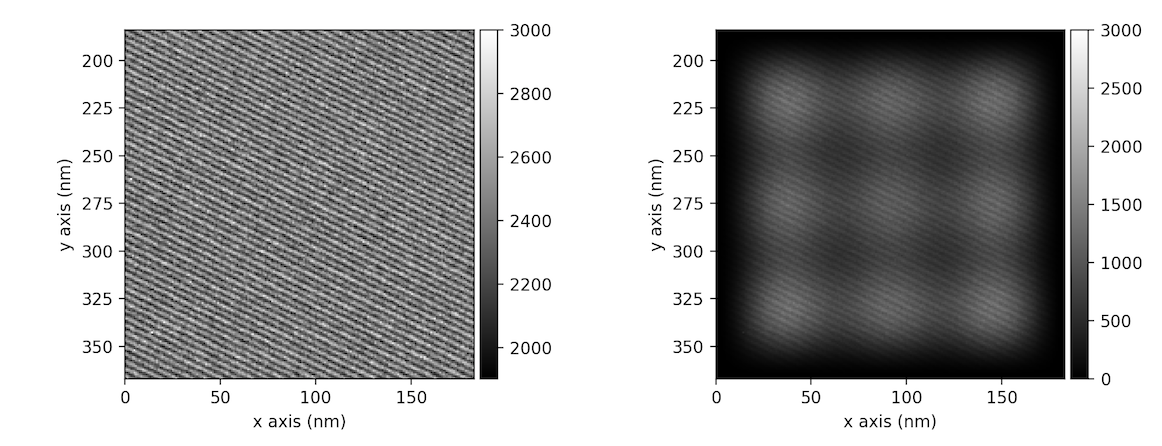
In addition to Hann window also Hamming or Tukey windows can be applied using window attribute
selecting 'hamming' or 'tukey' respectively.
The shape of Tukey window can be adjusted using parameter alpha
provided through tukey_alpha keyword argument (only used when window='tukey').
The parameter represents the fraction of the window inside the cosine tapered region,
i.e. smaller is alpha larger is the middle flat region where the original signal
is preserved. If alpha is one, the Tukey window is equivalent to a Hann window.
(Default value is 0.5)
Apodization can be applied in place by setting keyword argument inplace to True.
In this case method will not return anything.
Spike removal#
Cosmic rays or X-rays can cause intense pixels in the data. To correct for these experimental artifacts, two approaches are implemented in HyperSpy to remove spikes:
using a median filter - see
remove_spikes()using interpolation (Signal1D only) - see
spikes_removal_tool()
Using a median filter#
The remove_spikes() finds spikes using the following condition:
where \(\sigma\) is the standard deviation.
Where the condition above is fullfilled, the values are replaced by their local median.
The parameter threshold_factor can be specified by the user (default value is 5)
and the axes along which the median and the standard deviation are calculated can be specified
using the axes parameter.
Using interpolation (Signal1D only)#
spikes_removal_tool() provides an user
interface to remove spikes from spectra. The derivative histogram allows to
identify the appropriate threshold. It is possible to use this tool
on a specific interval of the data by slicing the data. For example, to use this tool in the signal between
indices 8 and 17:
>>> s = hs.signals.Signal1D(np.arange(5*10*20).reshape((5, 10, 20)))
>>> s.isig[8:17].spikes_removal_tool()
The options navigation_mask or signal_mask provide more flexibility in the
selection of the data, but these require a mask (booleen array) as parameter, which needs
to be created manually:
>>> s = hs.signals.Signal1D(np.arange(5*10*20).reshape((5, 10, 20)))
To get a signal mask, get the mean over the navigation space
>>> s_mean = s.mean()
>>> mask = s_mean > 495
>>> s.spikes_removal_tool(signal_mask=mask)
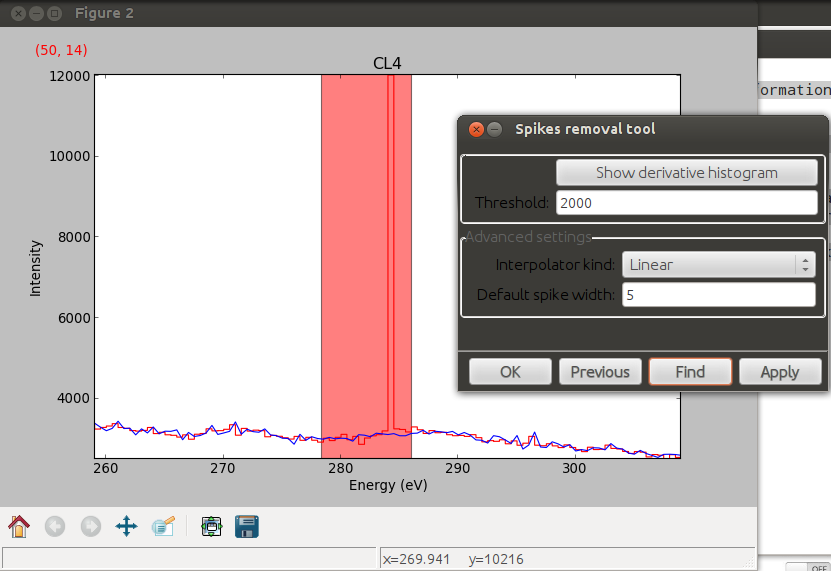
Spikes removal tool.#

